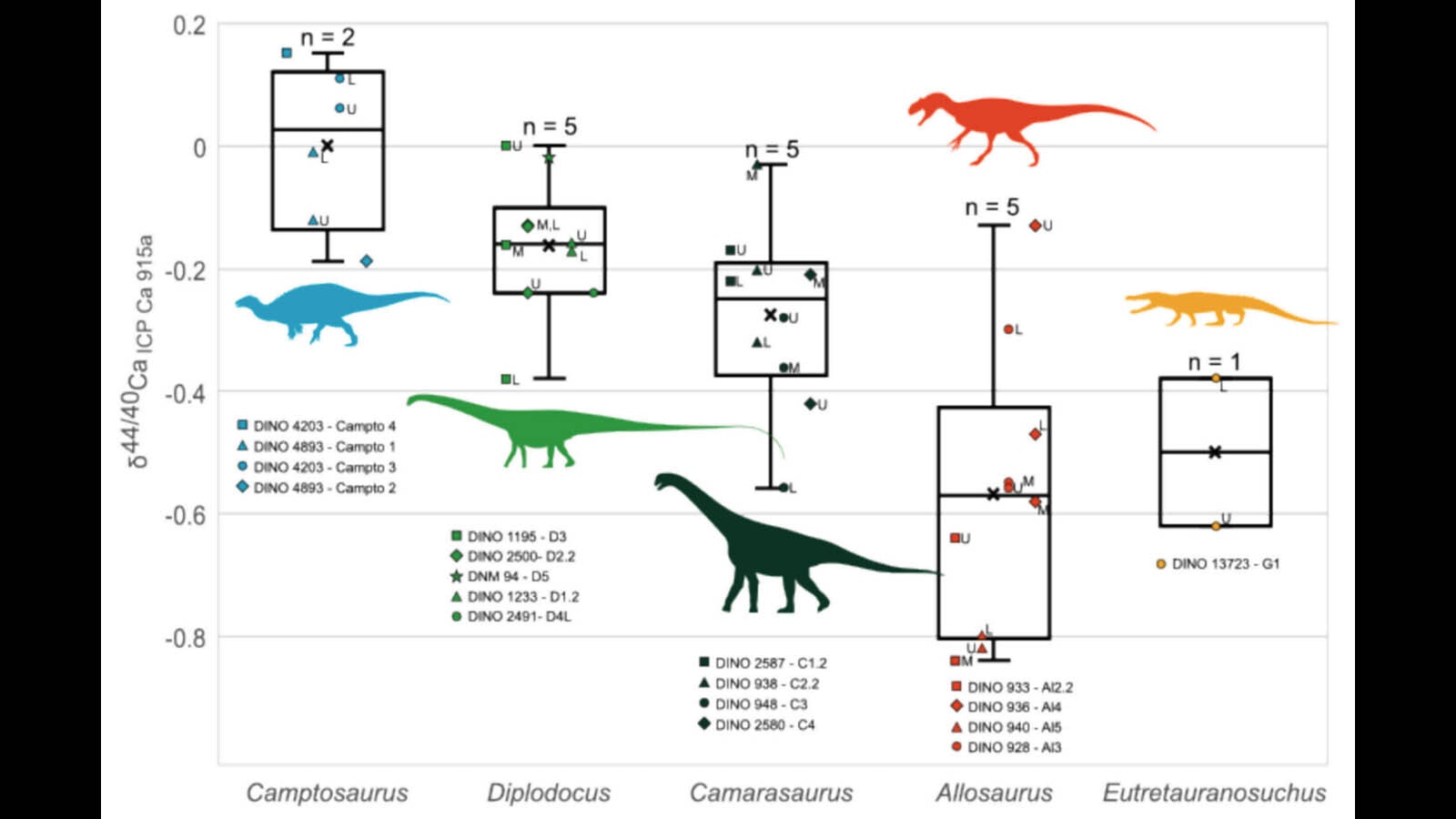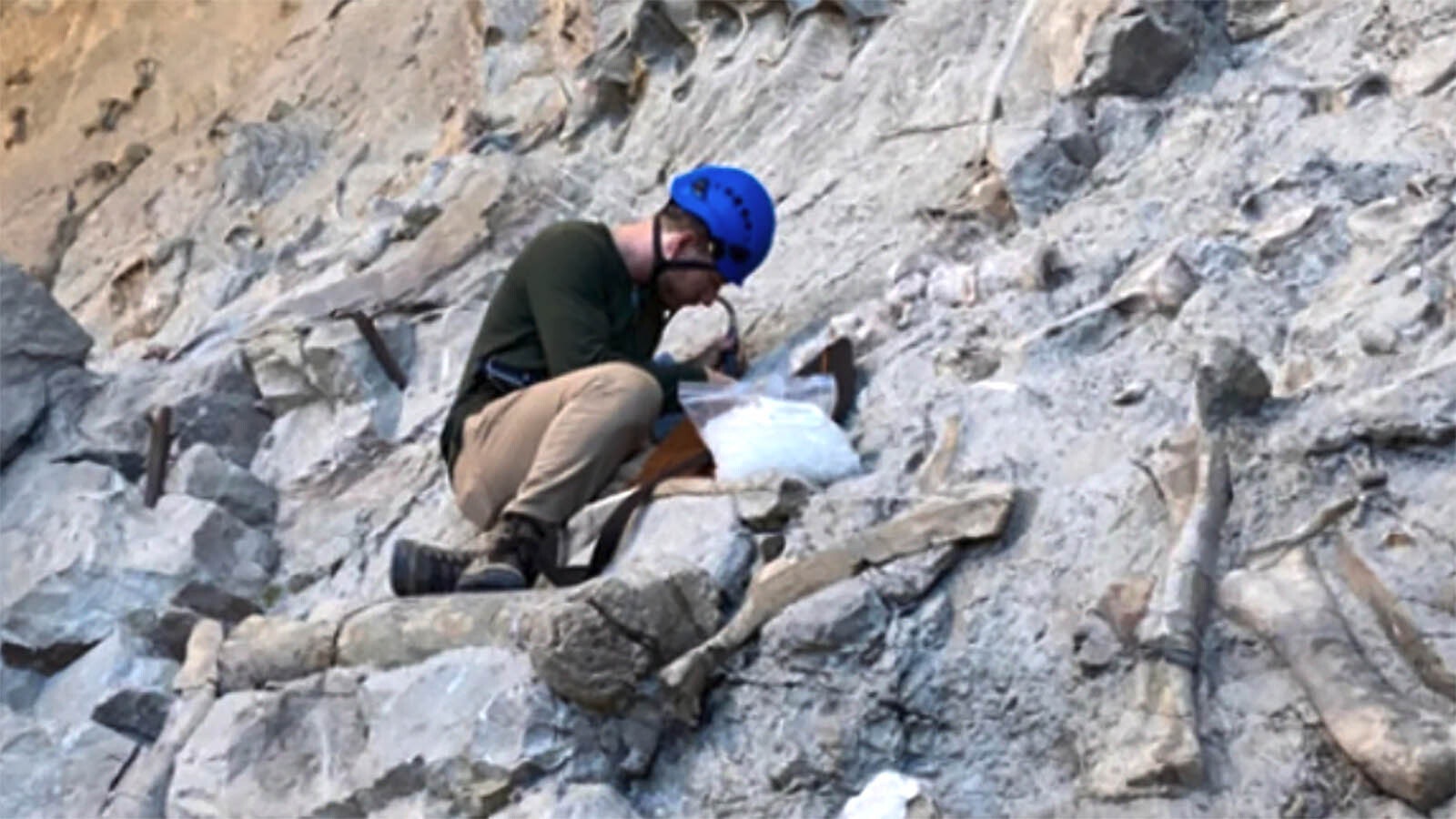What’s on the menu at the Dinosaur Diner depends on the customer.
Camptosaurus exclusively eats salads with plenty of leafy greens. So, keep the salad bar stocked with the good stuff, succulent and soft.
Camarasaurus is also vegan but much less picky. Keep it green, but feel free to add some roughage.
And Allosaurus?
Boneless wings and bone-out steak. If there’s even a scrap of bone, the apex predator of the Late Jurassic will have a bone to pick with the kitchen staff.
Humor aside, that’s a scientifically accurate menu from the Late Jurassic Period based on new research acquired from the analysis of dinosaur teeth from Dinosaur National Monument in Utah. Teeth can tell a life’s story, even when they’re 150 million years old.
“With teeth, you can track an entire food chain,” said Liam Norris, a paleontologist with the Department of Earth and Planetary Sciences at the University of Texas at Austin and lead author of the paper. “With this kind of research, we can ask questions about these animals and the environment they lived in that wouldn't have been possible 30 years ago.”

A Toothy Tale
Norris’ research focused on calcium isotopes preserved in the enamel of dinosaur teeth. And there are a lot them found in Wyoming.
Unlike the bones of prehistoric animals, which have transitioned from organic material to minerals over millions of years (a process called permineralization), enamel is so durable that it stays essentially unchanged.
“Enamel is not porous,” Norris said. “It’s a very hard material, especially when compared to bone or dentine, the inner material of teeth. Because of this, the isotopes preserved in that enamel will be super-robust and uncontaminated.”
All animals have isotopes of oxygen, carbon, nitrogen and calcium preserved in their enamel. One of the new frontiers in paleontological research is examining those isotopes to reveal details about extinct animals’ diets and environments.
Norris described enamel isotope studies as a relatively new field of study.
The first serious studies incorporating enamel isotopes were published in 1999, and the first paper on dinosaur enamel isotopes was only published in 2011.
“There have been a handful of studies since then, but none on the Late Jurassic environment of North America,” Norris said. “That’s why we picked the Morrison Formation for this research.
Norris specifically focused on calcium isotopes. Previous studies had uncovered incredible information from carbon and oxygen isotopes, but calcium isotopes haven’t been as thoroughly scrutinized.
Norris examined calcium isotopes from the teeth of four Late Jurassic dinosaurs: the long-necked sauropods Diplodocus and Camarasaurus, the bipedal herbivore Camptosaurus and Allosaurus, the most common carnivore in the Morrison Formation.
All the specimens in the study came from the jaws of skeletons found in the rock wall of Dinosaur National Monument (DNM), one of the world’s most famous and important dinosaur sites. Norris wanted to work there because of its vast diversity of dinosaur species that lived in the same place at the same time.
“The Morrison Formation spans 7 million years, but there are at least four species of sauropods that coexisted at DNM,” Norris said. “My main question was figuring out how those different species coexisted, and whether they had the same or different diets.”
Destructive Dino Dentistry
Nobody’s safe from the dentist in the 21st century. Even long-extinct dinosaurs are getting their teeth drilled and removed.
To conduct his research, Norris needed to do destructive sampling, drilling into the dinosaur teeth to obtain the samples that would be used to isolate and analyze the isotopes.
“The process of getting the actual sample is fairly simple,” he said. “I take a handheld Dremel, drill a little spot no more than two square millimeters, and get a very small amount of powdered enamel. Once I have that, it goes through a chemical process to isolate the calcium.”
Paleontologists can be very squeamish about destructive sampling. Fortunately, Norris had a team that eagerly gave him permission to destructively drill — for science.
He even made a “house call” for his research. While many of his enamel samples came from teeth that had already been destructively sampled, Norris obtained a fresh sample from a Camarasaurus skull still embedded in the vertical wall of fossils at DNM.
“Dr. Henry Fricke at Colorado College put me in touch with Rebecca Hunt-Foster at DNM,” he said. “She sent me specimens that had already been worked on, but I drove out to DNM to take some samples directly from the wall.”
Norris admits that the destructive sampling that made his research possible weighs on him. Fortunately, dinosaur teeth are abundant, and the results of his work have eased his guilty conscience.
“I have to sleep after knowing I've damaged these fossils, which have rested for hundreds of millions of years, untouched and in pristine condition,” he said. “But one of the benefits of calcium isotope sampling is that it's a very small sample mark.
“I'm not destroying the whole tooth, just taking a little portion of the enamel. That’s really nice compared to some of the other methods of destructive sampling.”

Light And Heavy Tooth Truths
The dinosaur enamel samples were run through a thermal ionization mass spectrometer to determine the ratio of light and heavy calcium isotopes preserved inside.
The calcium isotope ratios from each dinosaur tooth were compared to find overlaps and patterns, which revealed clues about each dinosaur’s diet.
“Animals get calcium from their food, and then that calcium is incorporated into their skeletons,” Norris said. “Animals will preferentially incorporate lighter calcium into their skeletons.
“So, as you go up the food chain, you'll have distinct ratios of light to heavy calcium in the skeletons of different animals.”
The heaviest calcium isotopes from the DNM dinosaurs were found in the teeth of Camptosaurus, the medium-sized bipedal herbivore that would have eaten ground-level vegetation. Norris said Camptosaurus ate mostly leaves, ferns, and cones.
“If animals eat the soft parts of plants, they have heavy calcium isotopes,” he said.
Meanwhile, the calcium isotopes from the much larger Diplodocus and Camarasaurus were much lighter. Camarasaurus had the lowest values in the study, suggesting it used its bulky teeth to indiscriminately eat any vegetation within reach — leaf, twig, and branch all in one bite.
According to Norris, this was “a big surprise” from the research.
“Previous work suggested that these calcium isotopes could work as a proxy for feeding height,” he said. “Tall animals would have heavier isotopes, and short animals would have lighter isotopes. And that was generally true where this type of work has been done, both in modern and fossil ecosystems.”
Norris’s research revealed that the tall, long-necked sauropods at DNM had lighter calcium isotopes than the short, smaller Camptosaurus.
“That was the opposite of the trend we were expecting, but we’ve confirmed it to be true,” he said.
Norris also said that the calcium isotope ratios of Camarasaurus and Diplodocus were similar, but not carbon copies (or, in this case, calcium copies) of each other. That was an expected outcome, given that the two sauropods are similar but very different.
“Their diets had overlap, but were not completely the same,” he said. “That makes sense. Their teeth are totally different, their heads are totally different shapes, and they probably held their necks at different heights. This was great confirmation of what we've hypothesized for a long time in this environment.”
Boneless Ribeyes
Norris also examined the calcium isotopes in the enamel of two carnivorous species preserved at DNM: the dinosaur Allosaurus and the crocodilian Eutretauranosuchus. He assumed the carnivores to have the lightest calcium isotopes, and that assumption was borne out.
“Their isotope values were lighter than the herbivores, but not much lighter,” he said.
One revealing discovery was that the calcium isotopes in Allosaurus enamel weren’t as light as those of other dinosaurian predators like Tyrannosaurus.
That indicates that Allosaurus was a flesh-eater, not a bone-cruncher.
“It's easy to distinguish between animals that eat bone versus animals that eat flesh,” he said. “Bone has more calcium than flesh does, obviously, so animals that eat any bone, their calcium values get really light, really fast.”
While Allosaurus certainly bit into and scraped bones while feeding, their enamel reveals that they probably avoided eating any bones. Tyrannosaurs, meanwhile, were built for crushing and consuming bone, based on their anatomy and previous isotope studies on tyrannosaur enamel that support this conclusion.
“The calcium isotopes of Allosaurus weren’t light enough to suggest bone-eating,” Norris said. “That’s consistent with what we know about Allosaurus and its diet. Their teeth were made for ripping, and their bite strength was not as (strong) as the tyrannosaurs. They ate flesh, not bone.”
Buffet For Brontosaurus
With this research, Norris has assembled the menu of the Late Jurassic’s most voracious appetites.
Camptosaurus selectively foraged on soft plants, meaning it had the most calcium-rich diet.
Camarasaurus, which indiscriminately chomped into and swallowed leaves, roots, and stems, got less calcium from tougher plants that it could easily process with its stronger jaws and robust teeth.
Diplodocus’s diet overlapped with that of both herbivores. While Camptosaurus and Camarasaurus had completely different diets, which makes sense given the disparity in size, Diplodocus probably competed with both dinosaurs for various food sources.
Allosaurus might have been a discerning diner, but it wasn’t a picky eater. Another conclusion from the calcium isotopes was that Allosaurus had the least specialized diet of all the DNM dinosaurs sampled. Any animal in its environment, including (as previous research has indicated) other Allosaurus, was on the menu.
But at least two other species of sauropod, two other large carnivorous dinosaurs, and several other medium-sized herbivores have been found at DNM. What were they eating?
Norris has ideas, but he’s eager to conduct more calcium isotope studies to confirm his speculations.
“I really wanted to look at the diet of Stegosaurus, but there just weren't enough teeth from DNM that I could sample,” he said. “That would be my next step on top of this study: going back and getting a more comprehensive view of this ecosystem.”
Order Up
Where does one go from here?
The possibilities aren’t infinite, but Norris believes it’s pretty darn close.
Norris is currently looking into dinosaur ontogeny, the study of how dinosaurs changed as they grew up. Calcium isotope studies could be used to determine if and how the diet of an Allosaurus or a Brontosaurus changed from hatchling to adult.
Then there are the other isotopes preserved in the enamel of dinosaur teeth. Norris referenced an earlier study conducted by Fricke, one of his co-authors, who used oxygen isotopes to confirm that dinosaurs migrated.
“Oxygen isotopes change, depending on whether you're at higher or lower altitudes,” he said. “Henry looked at the oxygen isotopes of Camarasaurus teeth and revealed that they were migrating up to the highlands, then down into the lowland environment preserved at DNM, where they would die or lose their teeth.”
Of course, Wyoming fossils could be prominent in this future research. Some of the best-preserved fossils ever found have come from sites across the Cowboy State, and they still hold plenty of secrets waiting to be extracted and analyzed.
Norris hopes his calcium isotope study will inspire other paleontologists to take a deep breath and allow more destructive sampling in future research projects. The prehistoric world of the dinosaurs is preserved in their teeth, and all that’s needed to unlock it is a hand drill and two millimeters of ancient enamel.
“More people should be doing this and applying it to the prehistoric ecosystems they are studying,” he said. “Pretty much anything can be done with these methods.”
Andrew Rossi can be reached at arossi@cowboystatedaily.com.








